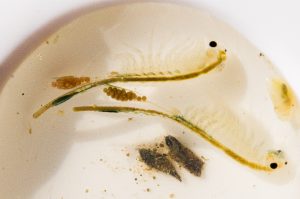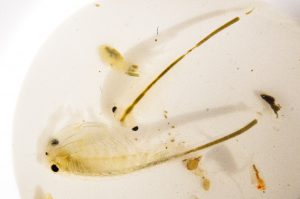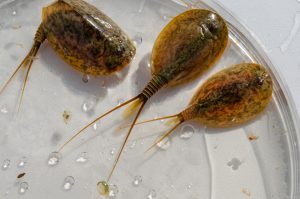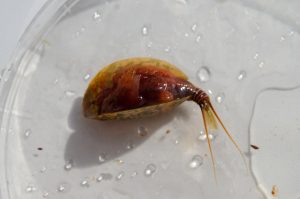Vernal Pool Crustaceans
A vernal pool is a world of exceptional diversity and an ecological system of unimaginable complexity. The organisms which inhabit this environment come in endless form and color, and all are superbly adapted to the rigorous environmental conditions associated with life in an ephemeral habitat. The uniqueness of such a habitat often produces equally unique organisms of very limited distribution, such as the Conservancy Fairy Shrimp and Vernal Pool Tadpole Shrimp (amongst others) that are found in the large playa pools at Jepson Prairie Preserve.
The Conservancy Fairy Shrimp (Branchinecta conservatio) is a Federally listed endangered species that was originally discovered at Jepson Prairie Preserve. Reproduction in this species is sexual, and the males
and females are easily distinguished. The males have long secondary antenna for clasping the females during mating. The female carries her eggs in a brood pouch suspended behind her last pair of legs . Fairy
shrimp aestivate by heat- and drought-resistant eggs called cysts.


Tadpole Shrimp (Lepidurus packardi) also are a Federally listed endangered species. An oval carapace covers the back and the two brood sacs can be seen on the underside between the shell and last pairs of legs. As Tadpole Shrimp grow, their number of legs increases, and they must shed their carapace. These can be found floating on the surface of the vernal pools. The red color of the legs comes from hemoglobin–the same substance that makes oxygenated mammalian blood red. They aestivate by eggs/cysts like the fairy shrimp.


What are Cysts?
Vernal pool endemic animals in the class Crustacea produce cysts that survive the long hot summers. A cyst is a living embryo encased in a hard shell. The shell helps the embryo survive the heat and desiccation of summer. When the rain returns, the embryo can hatch out very quickly to begin eating, growing and
reproducing. This is an advantage when your aquatic world lasts for only a few weeks or months.
